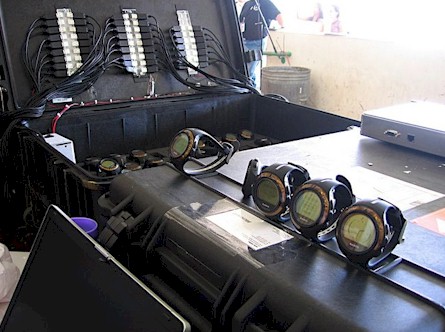|
Mainland High School
Suitable for a Disaster: ISTF 08-1835 |
||
|
Home
Introduction Contest Components One Two  Product Product
Three Fabrics History of Fabrics Smart Fabric Projects Sensors Nano Sensors Power Production Communication Cell Phones 3G Phones Data Transfer Helikites Interoperability Microwaves Relief Agencies Telecommunication Project Assessment Team |
Relief Agencies
The American Red Cross was founded on May 21, 1881 by Clara Barton. Starting in 1905, it runs under a Congressional charter and as an "instrument of the government" it is charged with carrying out the duties and responsibilities of the Geneva Convention. It's 50-member board of Governors is directed by the President of the Red Cross and makes decisions which are relayed through instructions to the directors of the 769 regional or city-based chapters. The Red Cross has an annual budget of $4.1 billion which is distributed at the national level and then to individual chapters. Red Cross chapters assist disaster areas based on three basic missions: food and water, shelter, or medical services. The director of each chapter establishes how the services are conducted. Periodically, check-ups of each chapter's activites are relayed to the board of governors. AT&T has recently spent 500 million dollars on augmenting and improving their Network Disaster Recovery (NDR) organization. AT&T is implementing this by constructing a new NDR Equipment Warehouse in the southeastern part of the USA and by expanding the NDR fleet. This organization quickly and efficiently establishes temporary wireless and wired connections in disaster areas. For example, after a disaster NDR will, as quickly as possible, make temporary repairs to any and all damaged towers and equipment to establish temporary connections until permanent repairs can be made. NDR response teams can use such recovery equipment as:
The Federal Emergency Managment Agency, FEMA, is a government agency composed of 10 operational regions. In 2003 FEMA became part of the Department of Homeland Security. FEMA responds to forest fires, earthquakes, tornadoes, hurricanes, tsunami, and chemical spills to help with clean up and attempt to preserve life. When a disaster occurs it is initially catagorized as level 1-5 (1 high level disaster, 5 low level disaster). FEMA then responds accordingly by establishing an incident command base, filling neccesary positions, and creating an incident action plan. The Strong Angel projects happen post-disaster in an effort to solve and reduce disaster-related consequences with the help of volunteers.
A Complex Contingency: A lethal and highly-contagious virus gradually begins
to spread around the globe. Infection rates are high, deaths are frequent, and no
vaccine is available. Cities all over the world fall under quarantine. Emergency
services and medical centers are stressed and national government agencies, affected
just as severely as the cities themselves, cannot provide assistance. And then the
situation goes from bad to worse. A terrorist cell, having long waited for such
an opportunity, launches a wave of successful cyber attacks in a medium size city
somewhere in the developed world, bringing down grid power, Internet access, land
and cellular telephones. Other, more subtle, attacks follow, and it's difficult
to sort out the mess.
Unlike the other Strong Angel projects, a scenario similar to what they were testing had yet to occur. They have increased and improved communication systems and technology to enhance the efficiency during a disaster scene. For example, they've developed watches that receive information and transmit information people might need, such as "GET DOWN! HERE COMES ANOTHER STORM SURGE!" or other important conditions. While wearing it they are also traceable from the information center that way everyone's always accounted for. If our system were to go into effect it would most likely first be tested in a Strong Angel project. About FEMA http://www.fema.gov/about/index.shtm AT&A Completes Itegration of Network Disaster Recovery Organization http://www.reuters.com/article/pressRelease/idUS192145+20-Nov-2008+PRN20081120 AT&A Completes Itegration of Network Disaster Recovery Organization Bedminster, New Jersey, November 20, 2008 http://www.att.com/gen/press-room?pid=4800&cdvn=news&newsarticleid=26331 A Brief History of the American Red Cross http://www.redcross.org/museum/history/brief.asp DARPA's Strong Angel II http://www.cra.org/govaffairs/blog/archives/000121.html FEMA's Organization Structure http://www.fema.gov/about/structure.shtm How the American Red Cross Works http://people.howstuffworks.com/american-red-cross3.htm International humanitarian law: the essential rules http://www.icrc.org/Web/Eng/siteeng0.nsf/html/5ZMEEM Network Disaster Recovery http://www.corp.att.com/ndr/ Picasa - Strong Angel III Images http://picasaweb.google.com/sanjanah/StrongAngelIII# Recovery Exercise http://www.corp.att.com/ndr/exercises_2008q4_photos.html Recovery Equipment http://www.corp.att.com/ndr/team_equipment.html Strong Angel http://vsee.com/photo/StrongAngel/ Strong Angel III http://www.strongangel3.net/ Strong Angel III Tests Military-Civil Disaster Response http://www.defenselink.mil/news/newsarticle.aspx?id=567 United States Department of Homeland Security/FEMA http://www.fema.gov/pdf/about/org_chart.pdf |




